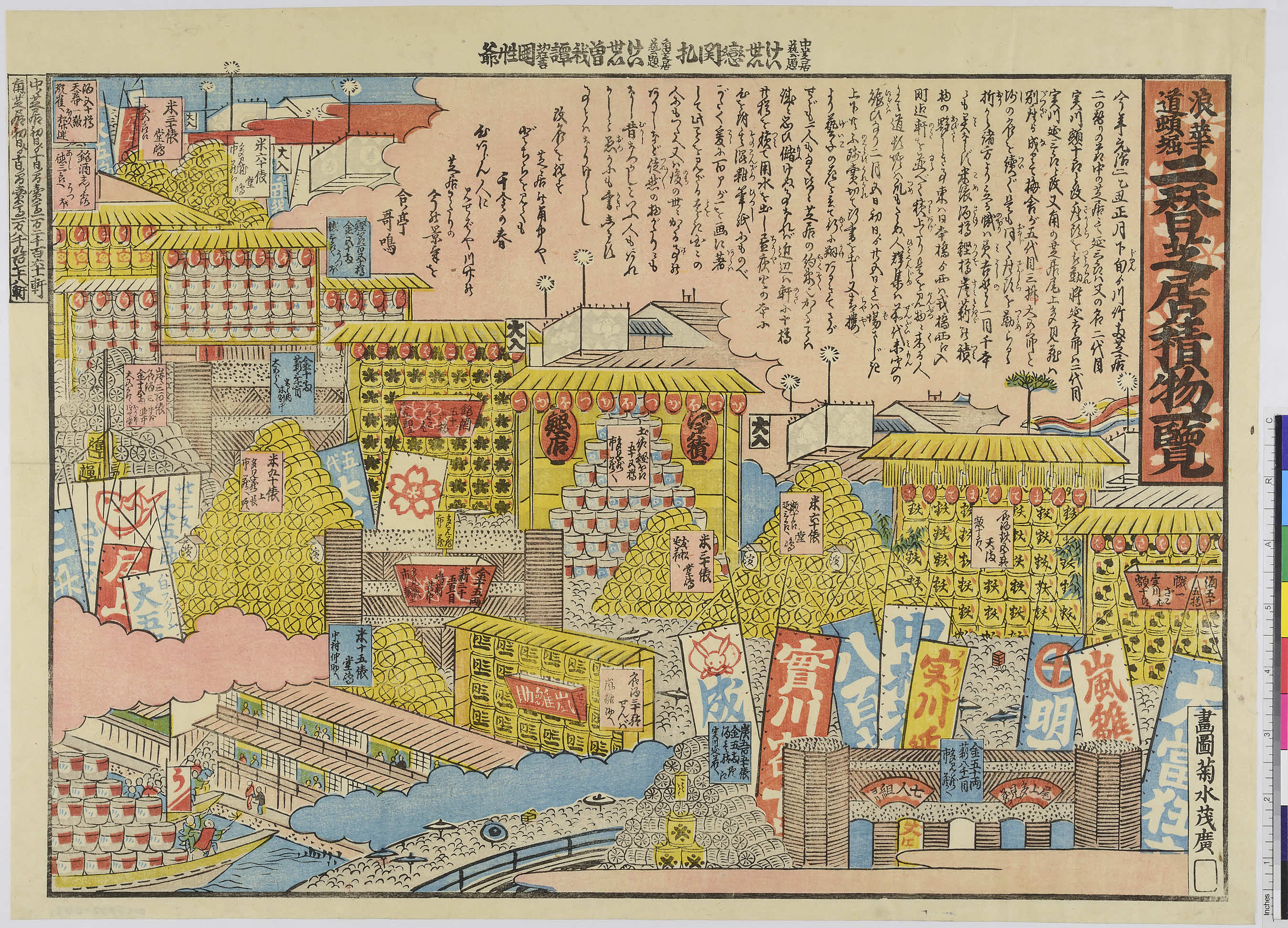C01 Lively Scene of Dotonbori
-
"Naniwa Dotonbori Ninokawari Shibai Tsumimono Ichiran"
Artist: Kikusui Shigehiro O-o-ban, Colour print
Published: January 1865(Genji 2), in Osaka
Ritsumeikan Art Research Center (arcSP02-0431)Tsumimono is stacked gifts from patrons to their favourite actor, which are stacked in front of a theatre to show every passerby as a tradition of Kabuki. Normally these high-rise stacked gift were to celebrate the opening performance of the performance year (Kaomise), but also sometimes theatre administrators did it to announce an actor's transfer or succession. The role of Tsumimono as an announcement of new performance year was lost from Meiji period, but the tradition itself has still existed. The gifts were various kind of things in Edo period, such as sake-casks, straw rice-bags, charcoals, and fire-woods. On the other hand, sake-casks are the most common gift from patrons. It is written that plenty of people had visited theatres to take a look at this gorgeous gift Tsumimono, as this picture shows us.
In this picture which depicts Dotonbori district in Osaka, there are five Yagura (tower) behind Tsumimono. The two towers in the center are the possession of Naka no Shibai theatre (the right one) and Kado no Shibai theatre(the left one). In Keian era (164-1652), the first permanent theatre was established and it was regarded as Kado no Shibai. The name of this theatre district "Dotonbori" came from the person named Yasui "Doton" who attributed to construction the street which had been just a wilderness before. From the beginning of this district, Kado no Shibai and Naka no Shibai were two representative Kabuki theatres of Osaka.
Tsumimono described in here was for announcement of an actor's transmission and succession of predecessor's name, so it's not the season of Kaomise but Ninokawari performance (second performance of the year). There are nineteen mountains of gifts in this picture and five of them are presented for Onoe Tamizo and Ichikawa Ichizo. The cartouche says that Onoe Tamizo was promoted to Betsuza which is one of three highest rank of actors and can be equal to Zagashira and Tachi-onnagata. This plenty of gifts might be for celebration of Tamizo the second's promotion. Ichizo who is mentioned here was Tamizo's son Ichikawa Ichizo the third. This is not mentioned in this picture, but both Onoe Tamizo and Ichizo were member of Kado no Shibai theatre. Therefore, their names appear on the same Tsumimono.
Originally, Tamizo came from Tokoyama in Kyoto and was not a member of representative actor families. In the beginning of his career, he mainly played on Miyajishibai (local Kabuki) in both Kamigata (Osaka and Kyoto area) and Edo. He eventually became popular so that he was appointed at more major theatres, such as Nakamura-za theatres in Edo and Kado no Shibai theatre in Osaka. The main clue of his popularity was not his appearance but his talent as an skillful actor and a dedicated entertainer, while some reviewers criticized his stage as too showery and unrefined. There is a story about Tamizo's surprising idea that he used an acrobat Hayatake Torakichi as a tiger which was gotten rid of by a great warrior Watonai in second act of Kokusenya Kassen in 1854 (Ansei 1). He often showed such unexpected entertainment to make audiences excited. There is also another story which proves Tamizo's various stage effects. When he played as a famous thief Ichikawa Goemon, he appeared from the suspended Japanese drum as floating in the air, which is one of highlight of this program called "Taiko nuke" (lit. escaping from Japanese drum). To see this spectacle, plenty of audiences visited the theatre every day.
This picture shows his huge popularity at that time. (,)
-

- 投稿日:
- by 8P
- カテゴリ: C Theatres and Promotion
- [編集]